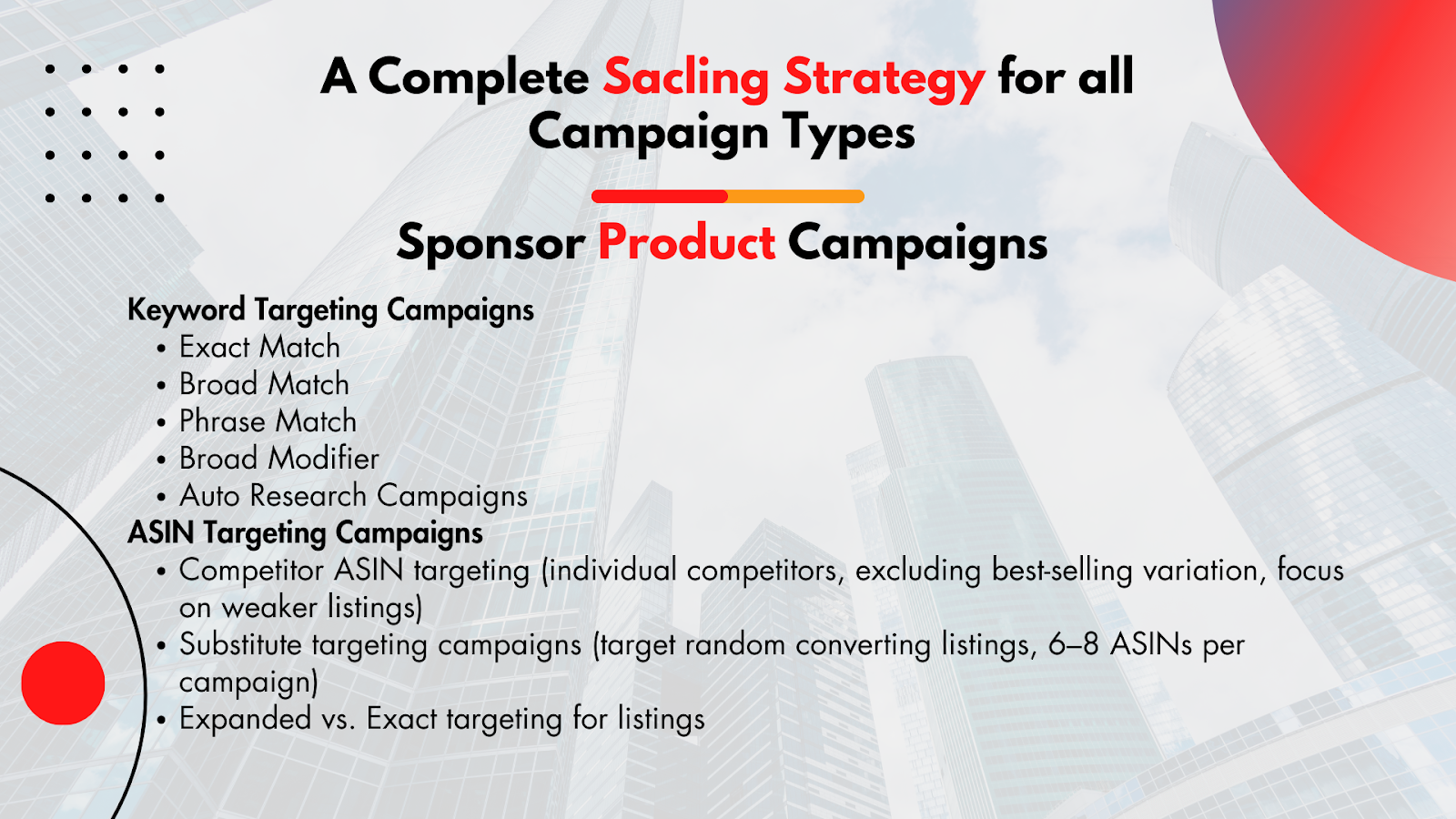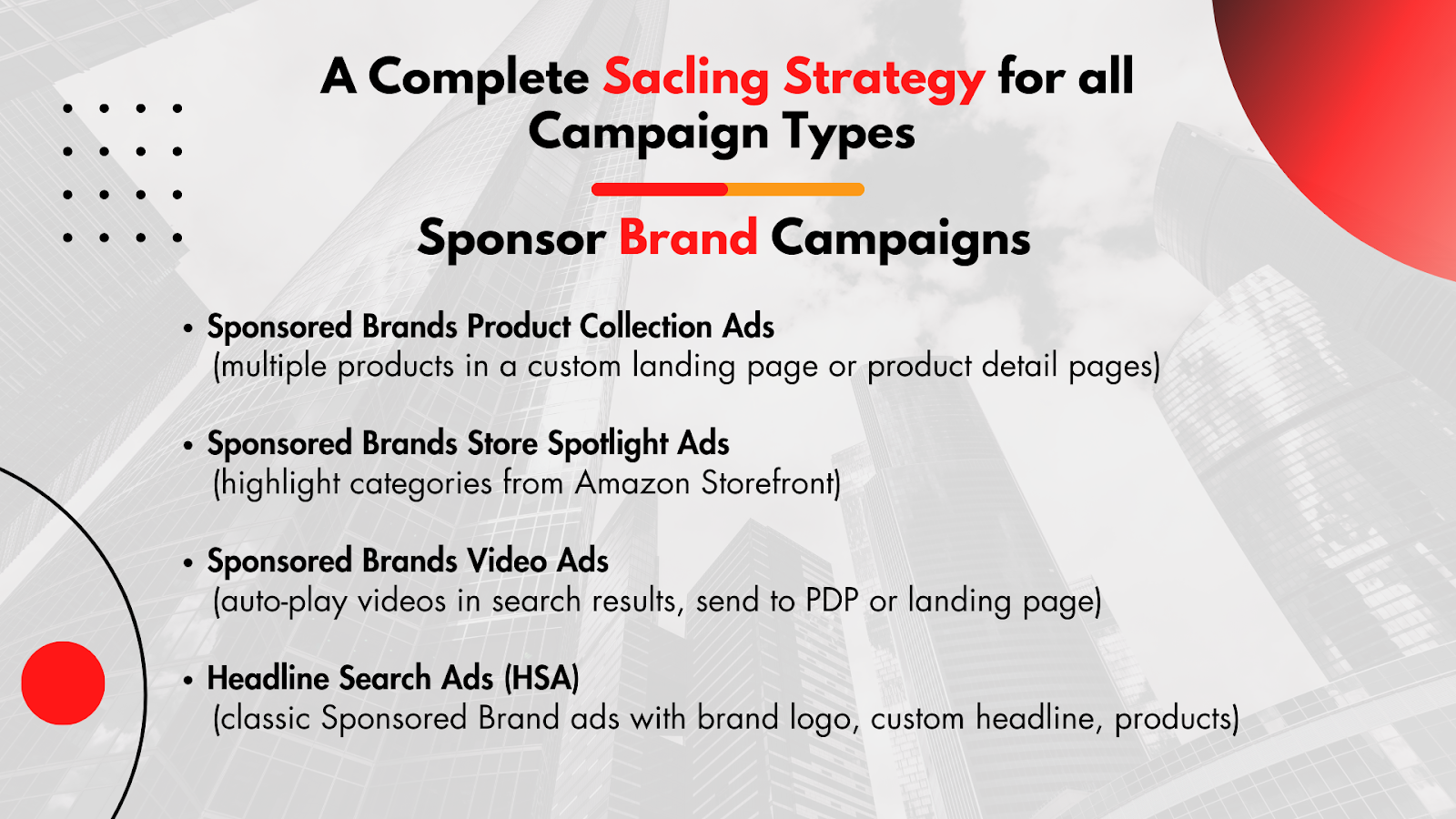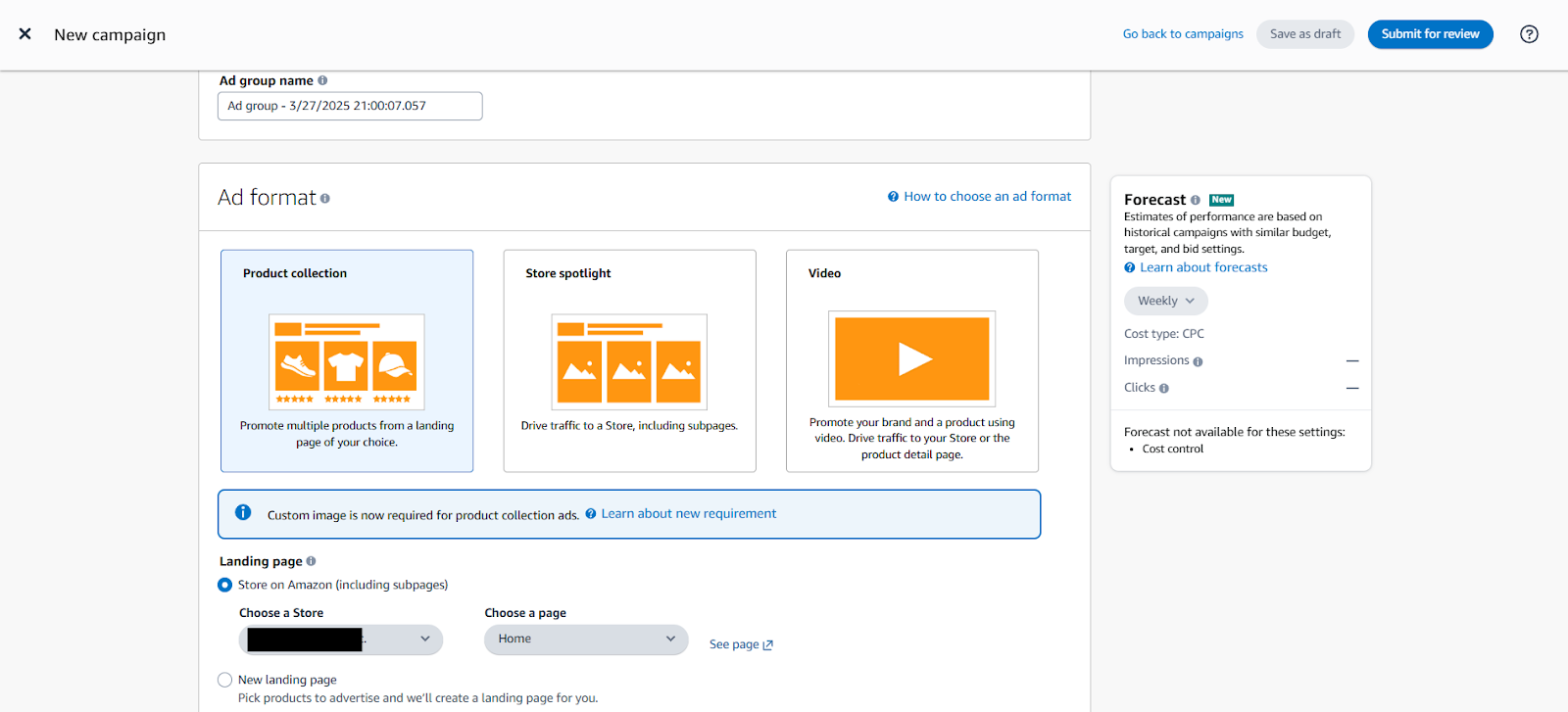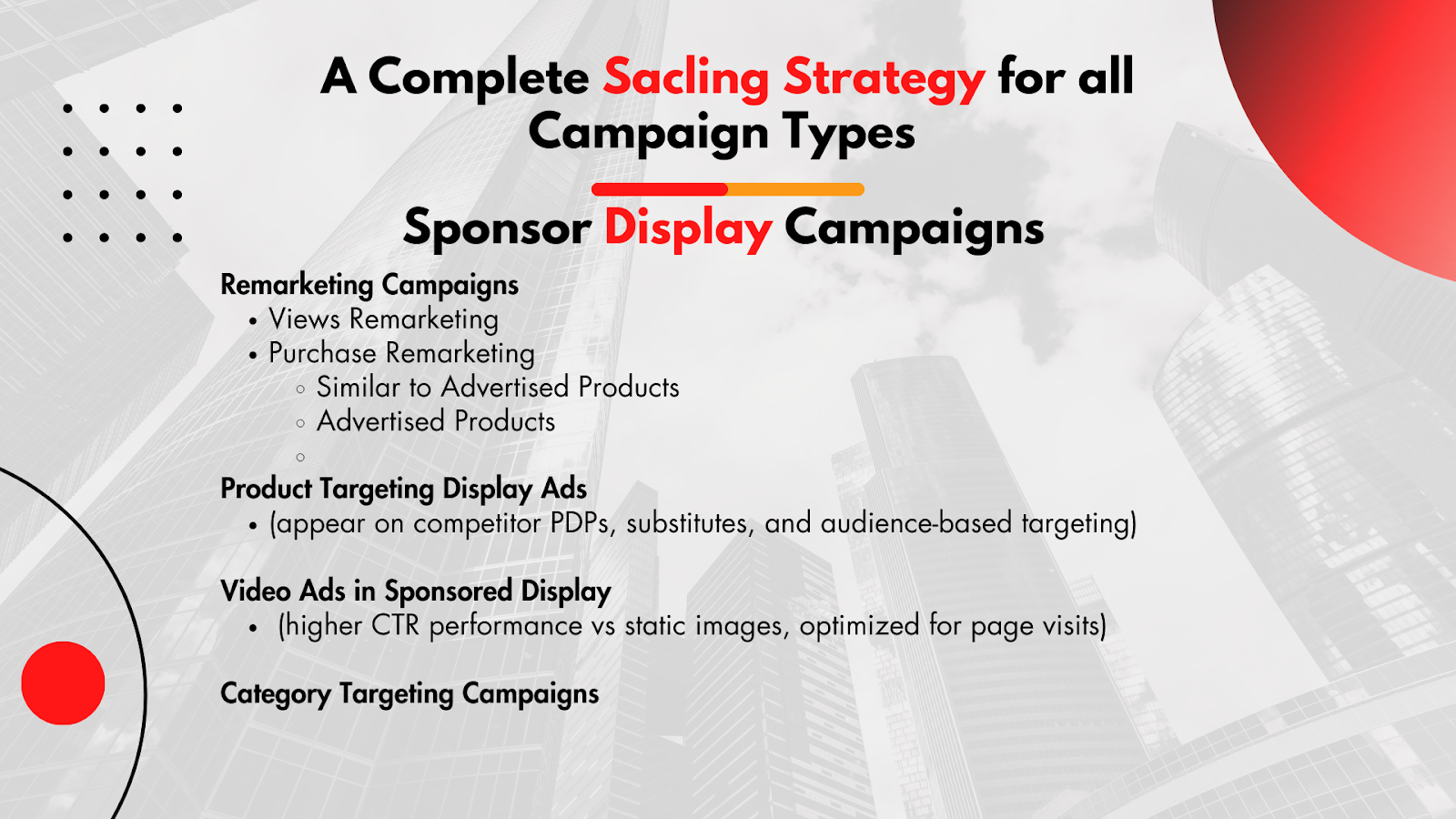Launching your brand on Amazon is exciting, but it is just the beginning. The real challenge and opportunity come in the scaling phase of your brand. This is the stage where your product has already found initial traction, your ads are converting well, and your organic sales are growing with time. The goal now is to expand your market share, start doing efforts to boost your profitability, and dominate your niche.
The scaling phase requires a lot more than just “spending more on ads.” It demands expert-level Amazon PPC campaign optimization not just focusing only on daily campaign bid, budget, or placement adjustment tweaks. The scaling phase requires strategic expansion into new keyword and audience segments, and a smart allocation of budgets to maximize ROI without burning cash. Amazon PPC Strategy for scaling phase optimization can easily turn a profitable product into a market leader if done in the right order.
In this guide, we’ll break down everything you need to know to manage your Amazon PPC advertising campaigns for the scaling phase of your brand, including budget management, targeting expansion, bid strategies, external traffic integration, and brand defense.
Table Of Content
- Custom Strategies for the Scaling Phase
- PPC Optimization for Scaling
- Keyword Ranking Strategy
- Amazon’s Algorithm and Revenue Priority
- ASIN Targeting Campaigns
- Product Targeting Campaigns and Additional Targeting Types
- Sponsored Brand Campaign Strategies
- What Are Sponsored Brands Ads?
- Types of Sponsored Brands Ads
- Using Sponsored Brands for Scaling
- Video Ads Strategy for Sponsored Brands
- Brand Registry Requirement
- Remarketing Campaigns via Sponsored Display
- Video Ads in Sponsored Display
- Other Scaling Strategies to Consider
- Final Thoughts
Custom Strategies for the Scaling Phase
When you talk about the scaling phase, then the things and the amazon advertising strategy are not ordinary or predefined. Every brand has to set up its own customized strategies based totally on the niche and the market competitiveness. But two core things that are included in scaling any brand are either to discover new root search terms which are not being noticed yet, or to launch a totally new variation or product line under the same brand.
PPC Optimization for Scaling
Well, the main focus is on the PPC optimization for the scaling phase of brands, but here are some quick details about the things or the steps you may consider for the scaling phase of your brand. If you are already doing well in all the previous phases of your PPC like the launching phase, the growth phase, the profitability phase, and now you are looking to scale your brand, then the strategy will be to work on more unique variation developments of your fastest selling product or an entrance into a totally new micro-niche. Because this time you already have a handsome amount of brand audience, it’s not very difficult to capture the market for a new variation or a new product line for you.
You can also start bundling your new product with the old one to educate your brand audience about your latest innovation. You have to allocate at least 20-30% of your total profits for scaling your brand and always put efforts either on a PPC side or the development side. PPC is one of the things which has unlimited potential. For example, till the 3rd phase you already captured around 10-12 keywords and totally captured two main roots which include those 10-12 keywords, then now in the scaling phase you need to find more roots and put effort and allot budget to conquer that root while maintaining your top ranks on every already ranked keyword.

Keyword Ranking Strategy
You always have to find more search terms for your product, but always keep in mind that rather than maintaining mid-level ranks on 20 keywords, it’s better to rank on top for 6-7 keywords as the majority of the clicks and sales happen on the topmost listings on Amazon. So you must first secure top ranks on the keywords that you are already targeting and putting efforts on, then you need to move towards the next keywords.
Always keep in mind to focus on a single root at a time as it gives more positive signals to Amazon’s algorithm. For example, if your product has around 6-7 roots and every root has multiple keywords, then the good practice is to focus on one root at a time, put full efforts and budgets to conquer all the keywords in that particular niche, and then move towards focusing on the other roots while maintaining the previous roots’ keyword ranks.
Always try to rank on the topmost spot, and once your product is ranked on the top you still need to run and optimize your PPC campaigns for that keyword, and your organic as well as sponsored ranks both should be the topmost. Otherwise, if you stop running your ads after ranking on top, then your top competitor will beat you very soon as they were continuously running ads on that particular keyword.
Amazon’s Algorithm and Revenue Priority
The concept is simple if you are running and building a business on Amazon and continuously expanding your audience reach, in the same way Amazon itself is also doing business in the market, and it is one of the biggest companies in the world. For Amazon, the brand and their audience or their customer is the priority, so Amazon always prioritizes those listings which are generating revenue for it.
Amazon already has a fixed percentage of the amount that it charges on each and every sale that happens on its platform and also charges for every click that happens on the sponsored listings on its platform. So if your sales are in multi-millions USD and you are also spending millions in PPC, then there is no way that any seller whose sales are far lower and spending far less on that particular keyword can beat you.
Remember, the top-ranked listing on a keyword is most of the time also the top revenue-generating listing on Amazon. But the good thing is, when you also rank organically not just through sponsored rank, then your PPC and organic sales share ideally should be like 20-30% PPC sales and 70-80% organic sales share so that your TACoS will be much lower than the previous phase.
ASIN Targeting Campaigns
This will be the strategy for conquering more and more keywords through keyword targeting campaigns of Sponsored Product Ads. Now let’s discuss product targeting campaigns.
When you are in the scaling phase, you most probably already have some ASIN targeting campaigns set up in your campaigns portfolio. But now, as you are already out of the struggling phase, you have room to test different things and filter out what’s working and what’s not.
If there are 6-7 top closest competitors of your brand, then you should have — or if you don’t have, then launch — competitor targeting campaigns for each competitor. You can target their ASIN in the same campaign, but each campaign should include listings that belong to the same brand.
If you want to filter more, then for example, if the competitor has 10 variations, do not add the highest selling variation in your targeting as the conversion rate might already be good on that listing. Instead, focus on targeting those listings which look less engaging than your listing and your offer is also better than those.
You can add multiple products in advertising, and also your bid and placement percentages should not be much lower than the suggested bids — in fact, either the same or higher than suggested. Do repeat the same process for all competitors, and your targeting type should be exact, not expanded. The nomenclature of the campaigns should follow the same pattern which you are following for all your campaigns and should add the name of the competitor brand in the name of your Amazon PPC campaign to manage and analyze the performance easily.
When there are some random listings which you find through your substitute campaign and your product is converting well on those listings, then you can target those in separate product targeting campaigns with around 6-8 targeting ASINs in a single campaign. You can run as expanded to explore more such listings or run exact to fully focus on those particular listings it totally depends on you.
One key factor that you might be unfamiliar with is that when you are targeting any listing through product targeting campaigns, your ad will also appear on those keywords on which your competitor is already ranked.
Other Targeting Campaigns Types
Side by side, these two main categories: ASIN targeting and Exact Keyword targeting — you must also be running campaigns in Broad, Phrase, Broad Modifier type targeting, and also Auto Research campaigns to always find new potential keywords.
Sponsored Brand Campaign Strategies
Now we have covered the strategy for Sponsored Product type campaigns; let’s look into Sponsored Brand campaigns.
There are multiple kinds of ads you can run using Sponsored Brand ads, and technically Sponsored Brand type ads are a kind of brand awareness campaign. There are multiple categories in Sponsored Brand type PPC ads, such as:

What Are Sponsored Brands Ads?
Sponsored Brands Ads are a type of Amazon PPC advertising designed to help brands increase visibility and drive traffic to their product listings or storefronts. These ads appear on the top or middle of Amazon search results and feature a brand logo and a custom headline and single or multiple product listings as per your selection.
If you want to learn more about Amazon PPC Strategy from the basics to advanced strategies, including launch strategy, check out our detailed blogs below:
- Click here to learn about Amazon PPC Basics and Launch Strategy
- Click here to learn about Amazon PPC Optimization Strategy for Established Brands
Types of Sponsored Brands Ads

- Sponsored Brands Product Collection Ads
These ads showcase multiple products from the same brand and allows customers to explore and directly purchase them. They direct traffic to either a custom landing page that features selected products or individual product detail pages not necessarily the Amazon Storefront.
- Sponsored Brands Store Spotlight Ads
Designed for brand-building, these ads highlight different product categories within a brand’s Amazon Storefront. Clicking on a section takes users to the corresponding Storefront subpage, increasing overall brand engagement rather than focusing on direct product sales.

- Sponsored Brands Video Ads
These are video-based ads that play automatically within search results, providing an engaging way to showcase product features, benefits, and use cases. These ads direct shoppers to a specific product detail page or a custom landing page.
Using Sponsored Brands for Scaling
The two main kinds of ads people usually run are Headline (HSA) Ads or Sponsored Brand Video Ads. Both are useful in creating awareness of your brand among the audience, and you must try multiple keywords and techniques, then filter out what’s working well for your brand and what’s not.
The good part is, unlike Sponsored Product ads where if your product is getting clicks but not converting well, Amazon’s algorithm may start to derank your listing. Sponsored Brand ads don’t have a negative ranking impact if conversion rates are low.
Therefore, you should run multiple kinds of Sponsored Brands ads on multiple relevant keywords. Also, unlike Keyword Targeting campaigns where we recommend targeting a single keyword per campaign, in Sponsored Brand ads you can run multiple keywords in a single campaign.
Video Ads Strategy for Sponsored Brands
Video ads are often very beneficial, so if you are not leveraging them yet, you should add them to your strategy. If you want to learn more about video ads, check out our latest blog on How to Use Video Content to Boost Amazon Conversion Rates, where we have covered every detail you need to know about Video Ads.
The best part is, although HSA and Video ads do not directly influence keyword ranking, they can have a positive impact because of the revenue generation they drive. Amazon will give a boost to the indexed keywords of your listing. Therefore, you must run Video and HSA ads on all your potential keywords, filter out the best performers, and pause the rest.
Sponsored Display Ads Strategies
Now we have covered strategies for Sponsored Product and Sponsored Brand ads; let’s discuss Sponsored Display Ads strategies.
Sponsored Display Ads are one of the most underutilized ad types on Amazon, perhaps because sellers usually don’t focus on them in the beginning. However, once your brand is out of the struggling phase, you should definitely explore Sponsored Display Ads, as there are multiple types of ads you can run through this format.

Brand Registry Requirement
One thing to always remember is that only Brand Registered sellers on Amazon get access to Sponsored Brands and Sponsored Display Ads. If you are not registered yet, register your brand on Amazon through the Amazon Brand Registry now.
If you want to learn how to register your brand on Amazon, check out our detailed blog on How to Register Your Brand on Amazon.
Remarketing Campaigns via Sponsored Display
The most commonly and widely used amazon ppc campaign strategy for Sponsored Display ads is Remarketing Campaigns. If your brand is already in a stable position and you are continuously putting in efforts to grow further, you must add Sponsored Display Remarketing Campaigns in your Amazon PPC Strategy for scaling phase.
There are two major types:
- Views Remarketing
- Purchase Remarketing
These further split into:
- Similar to Advertised Products
- Advertised Products
It is recommended to try all of these, filter out the best-performing campaigns, and pause the rest.
Video Ads in Sponsored Display
You can also run video ads through Sponsored Display. A recent 2024 study by Amazon stated that advertisers who use video ad format for Sponsored Display and optimize for page visits saw a 67% higher click-through rate (CTR) compared to those using image creatives.
If you want to learn more in detail, check out our latest blog on A Detailed Guide on Amazon PPC Sponsored Display Ads Strategies.
Other Scaling Strategies to Consider
Now we have completely discussed the Amazon PPC Strategy for the Scaling Phase of your brand.
There are many other things you must focus on in the scaling phase, including:
- External traffic sources for your product
- Influencer marketing campaigns to increase brand reach
- TikTok Shop setup and making your product go viral
- Use of Amazon Attribution program
- Custom website setup for your brand
- New variation/product launches
If you want to learn more about all of the above-mentioned details, check out our latest blog on How to Scale Your Brand on Amazon as the main focus of the above blog is on the PPC Strategy for scaling.
Final Thoughts
The scaling phase of your Amazon PPC strategy is where you transition from being a profitable seller to becoming a dominant brand in your category. It’s a delicate balance between aggressive expansion and careful cost control. By optimizing existing campaigns, expanding your keyword and audience reach, leveraging external traffic, and protecting your brand presence, you can maximize ROI and cement your position as a market leader.
Ready to unlock the full potential of your Amazon PPC campaigns? Let us design a tailored scaling strategy that drives higher rankings, unstoppable revenue growth, and a dominant brand presence. Book your free consultation with our experts today and start scaling smarter!




.avif)
.svg)

.png)
.jpg)
.svg)







